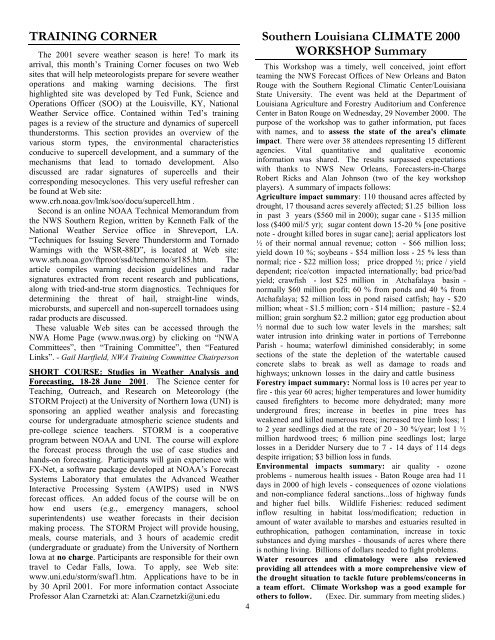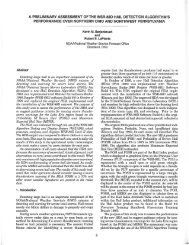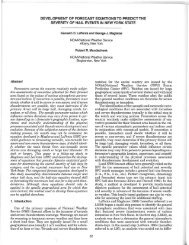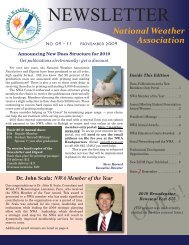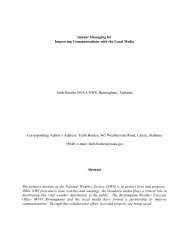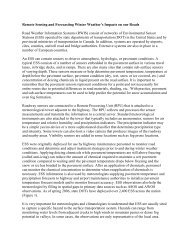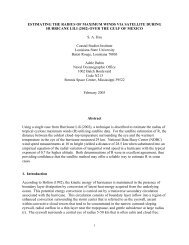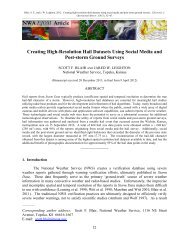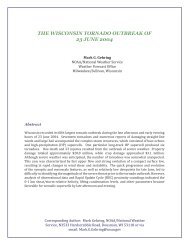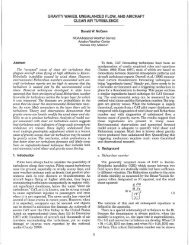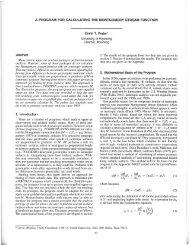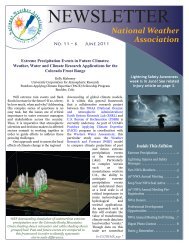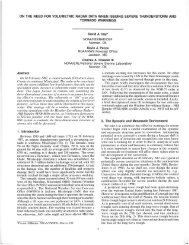January 2001 - National Weather Association
January 2001 - National Weather Association
January 2001 - National Weather Association
Create successful ePaper yourself
Turn your PDF publications into a flip-book with our unique Google optimized e-Paper software.
TRAINING CORNER<br />
The <strong>2001</strong> severe weather season is here! To mark its<br />
arival, this month’s Training Corner focuses on two Web<br />
sites that will help meteorologists prepare for severe weather<br />
operations and making warning decisions. The first<br />
highlighted site was developed by Ted Funk, Science and<br />
Operations Officer (SOO) at the Louisville, KY, <strong>National</strong><br />
<strong>Weather</strong> Service ofice. Contained within Ted’s training<br />
pages is a review of the structure and dynamics of supercell<br />
thunderstorms. This section provides an overview of the<br />
various storm types, the environmental characteristics<br />
conducive to supercell development, and a summary of the<br />
mechanisms that lead to tornado development. Also<br />
discussed are radar signatures of supercells and their<br />
corresponding mesocyclones. This very useful refresher can<br />
be found at Web site:<br />
www.crh.noaa.gov/lmk/soo/docu/supercell.htm .<br />
Second is an online NOAA Technical Memorandum from<br />
the NWS Southern Region, written by Kenneth Falk of the<br />
<strong>National</strong> <strong>Weather</strong> Service office in Shreveport, LA.<br />
“Techniques for Isuing Severe Thunderstorm and Tornado<br />
Warnings with the WSR-88D”, is located at Web site:<br />
www.srh.noaa.gov/ftproot/ssd/techmemo/sr185.htm. The<br />
article compiles warning decision guidelines and radar<br />
signatures extracted from recent research and publications,<br />
along with tried-and-true storm diagnostics. Techniques for<br />
determining the threat of hail, straight-line winds,<br />
microbursts, and supercell and non-supercell tornadoes using<br />
radar products are discussed.<br />
These valuable Web sites can be accessed through the<br />
NWA Home Page (www.nwas.org) by clicking on “NWA<br />
Commitees”, then “Training Commitee”, then “Featured<br />
Links”. - Gail Hartfield, NWA Training Committee Chairperson<br />
SHORT COURSE: Studies in <strong>Weather</strong> Analysis and<br />
Forecasting, 18-28 June <strong>2001</strong>. The Science center for<br />
Teaching, Outreach, and Research on Meteorology (the<br />
STORM Project) at the University of Northern Iowa (UNI) is<br />
sponsoring an applied weather analysis and forecasting<br />
course for undergraduate atmospheric science students and<br />
pre-college science teachers. STORM is a cooperative<br />
program between NOAA and UNI. The course will explore<br />
the forecast process through the use of case studies and<br />
hands-on forecasting. Participants will gain experience with<br />
FX-Net, a software package developed at NOAA’s Forecast<br />
Systems Laboratory that emulates the Advanced <strong>Weather</strong><br />
Interactive Processing System (AWIPS) used in NWS<br />
forecast offices. An added focus of the course will be on<br />
how end users (e.g., emergency managers, school<br />
superintendents) use weather forecasts in their decision<br />
making process. The STORM Project will provide housing,<br />
meals, course materials, and 3 hours of academic credit<br />
(undergraduate or graduate) from the University of Northern<br />
Iowa at no charge. Participants are responsible for their own<br />
travel to Cedar Falls, Iowa. To apply, see Web site:<br />
www.uni.edu/storm/swaf1.htm. Applications have to be in<br />
by 30 April <strong>2001</strong>. For more information contact Associate<br />
Professor Alan Czarnetzki at: Alan.Czarnetzki@uni.edu<br />
4<br />
Southern Louisiana CLIMATE 2000<br />
WORKSHOP Summary<br />
This Workshop was a timely, well conceived, joint effort<br />
teaming the NWS Forecast Offices of New Orleans and Baton<br />
Rouge with the Southern Regional Climatic Center/Louisiana<br />
State University. The event was held at the Department of<br />
Louisiana Agriculture and Forestry Auditorium and Conference<br />
Center in Baton Rouge on Wednesday, 29 November 2000. The<br />
purpose of the workshop was to gather information, put faces<br />
with names, and to assess the state of the area's climate<br />
impact. There were over 38 attendees representing 15 different<br />
agencies. Vital quantitative and qualitative economic<br />
information was shared. The results surpassed expectations<br />
with thanks to NWS New Orleans, Forecasters-in-Charge<br />
Robert Ricks and Alan Johnson (two of the key workshop<br />
players). A summary of impacts follows:<br />
Agriculture impact summary: 110 thousand acres affected by<br />
drought, 17 thousand acres severely affected; $1.25 billion loss<br />
in past 3 years ($560 mil in 2000); sugar cane - $135 million<br />
loss ($400 mil/5 yr); sugar content down 15-20 % [one positive<br />
note - drought killed bores in sugar cane]; aerial applicators lost<br />
½ of their normal annual revenue; cotton - $66 million loss;<br />
yield down 10 %; soybeans - $54 million loss - 25 % less than<br />
normal; rice - $22 million loss; price dropped ½; price / yield<br />
dependent; rice/cotton impacted internationally; bad price/bad<br />
yield; crawfish - lost $25 million in Atchafalaya basin -<br />
normally $60 million profit; 60 % from ponds and 40 % from<br />
Atchafalaya; $2 million loss in pond raised catfish; hay - $20<br />
million; wheat - $1.5 million; corn - $14 million; pasture - $2.4<br />
million; grain sorghum $2.2 million; gator egg production about<br />
½ normal due to such low water levels in the marshes; salt<br />
water intrusion into drinking water in portions of Terrebonne<br />
Parish - houma; waterfowl diminished considerably; in some<br />
sections of the state the depletion of the watertable caused<br />
concrete slabs to break as well as damage to roads and<br />
highways; unknown losses in the dairy and cattle business<br />
Forestry impact summary: Normal loss is 10 acres per year to<br />
fire - this year 60 acres; higher temperatures and lower humidity<br />
caused firefighters to become more dehydrated; many more<br />
underground fires; increase in beetles in pine trees has<br />
weakened and killed numerous trees; increased tree limb loss; 1<br />
to 2 year seedlings died at the rate of 20 - 30 %/year; lost 1 ½<br />
million hardwood trees; 6 million pine seedlings lost; large<br />
losses in a Deridder Nursery due to 7 - 14 days of 114 degs<br />
despite irrigation; $3 billion loss in funds.<br />
Environmental impacts summary: air quality - ozone<br />
problems - numerous health issues - Baton Rouge area had 11<br />
days in 2000 of high levels - consequences of ozone violations<br />
and non-compliance federal sanctions...loss of highway funds<br />
and higher fuel bills. Wildlife Fisheries: reduced sediment<br />
inflow resulting in habitat loss/modification; reduction in<br />
amount of water available to marshes and estuaries resulted in<br />
euthrophication, pathogen contamination, increase in toxic<br />
substances and dying marshes - thousands of acres where there<br />
is nothing living. Billions of dollars needed to fight problems.<br />
Water resources and climatology were also reviewed<br />
providing all attendees with a more comprehensive view of<br />
the drought situation to tackle future problems/concerns in<br />
a team effort. Climate Workshop was a good example for<br />
others to follow. (Exec. Dir. summary from meeting slides.)


